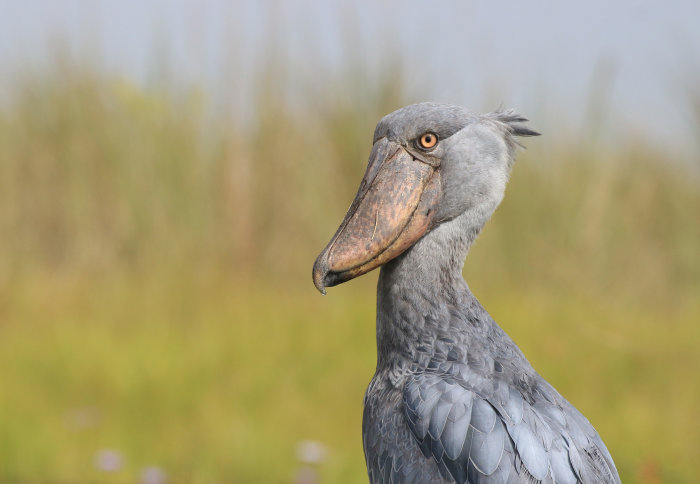50 billion years of evolutionary history threatened by human activity

Shoebill bird. Credit: Claudia Gray/ZSL
Unique animals with long evolutionary histories are under increased threat of extinction around the world, according to a new study.
The study, led by ZSL and Imperial College London and published in Nature Communications, highlights species that should be priorities for conservation.
Our analyses reveal the incomprehensible scale of the losses we face if we don’t work harder to save global biodiversity. Rikki Gumbs
Many of these unique species live in areas that are facing unprecedented levels of human pressure from activities such as urban development, deforestation and road building, including the Caribbean, the Western Ghats of India, and large parts of Southeast Asia.
The team mapped the evolutionary history – how a species has evolved over time and which other species it is closely related to – of the world’s amphibians, birds, mammals and reptiles.
Because many species evolved side by side on separate branches of the evolutionary tree, the amount of cumulative evolutionary history represented by each group of animals can be incredibly large. For example, reptiles alone contain about 13 billion years of evolutionary history, which is about the age of the Universe.
In total, the team calculated that at least 50 billion years of evolutionary history is under threat across the animal group studied, and that this is likely to be an underestimate, as there are many species we don’t know enough about.
Incomprehensible scale of losses
Lead author Rikki Gumbs, of ZSL’s EDGE of Existence programme and the Science and Solutions for a Changing Planet Doctoral Training Partnership at Imperial College London, said: “Our analyses reveal the incomprehensible scale of the losses we face if we don’t work harder to save global biodiversity.”
Some of the greatest losses of evolutionary history will be driven by the extinction of entire groups of closely related species that share long branches of the tree of life, such as pangolins and tapirs, which also perform vital functions like seed dispersal and pest control in their local ecosystems.
Much of the loss will also be made up of highly evolutionarily distinct species that sit alone at the ends of extremely long branches, such as the ancient Chinese crocodile lizard (Shinisaurus crocodilurus), the shoebill bird (Balaeniceps rex), and the aye-aye (Daubentonia madagascariensis), a nocturnal lemur with large yellow eyes and long spindly fingers.
You can explore where these animals sit on the tree of life with the OneZoom explorer, initially invented by study co-author Dr James Rosindell, from the Department of Life Science at Imperial.
This new study highlights priority species for conservation, based on their evolutionary uniqueness and the intense human pressure across the environments where they are thought to live. Many of these species are also a priority for ZSL’s EDGE of Existence programme, which works to conserve the world’s most evolutionarily distinct and threatened species from extinction.
Several weird and wonderful EDGE Species in the new study are urgent conservation priorities – including the punk-haired Mary River turtle (Elusor macrurus), the purple frog (Nasikabatrachus sahyadrensis), and the numbat (Myrmecobius fasciatus).
Gumbs added: “These are some of the most incredible and overlooked animals on Planet Earth. From legless lizards and tiny blind snakes to pink worm-like amphibians called caecilians, we know precious little about these fascinating creatures, many of which may be sliding silently toward extinction.”
Incredible and overlooked animals
The study also highlights many lesser known species as priorities for further research, with more than half of the priority lizards and snakes identified currently lacking adequate extinction risk data.
Jointly led by ZSL and Imperial College London – with the University of Oxford, Yale University, Tel Aviv University, Ben-Gurion University and On The EDGE Conservation – the study also identifies regions where concentrations of irreplaceable diversity are currently under little to no human pressure, particularly across the Amazon rainforest, the highlands of Borneo, and parts of southern Africa.
Dr Rosindell said: “Our findings highlight the importance of acting urgently to conserve these extraordinary species and the remaining habitat that they occupy in the face of intense human pressures.”
-
‘Global priorities for conservation of reptilian phylogenetic diversity in the face of human impacts’ by Rikki Gumbs, Claudia L. Gray, Monika Böhm, Michael Hoffmann, Richard Grenyer, Walter Jetz, Shai Meiri, Uri Roll, Nisha R. Owen & James Rosindell is published in Nature Communications.
Based on a press release by ZSL. Read more on ZSL's blog.
Article supporters
Article text (excluding photos or graphics) © Imperial College London.
Photos and graphics subject to third party copyright used with permission or © Imperial College London.
Reporter
Hayley Dunning
Communications Division





